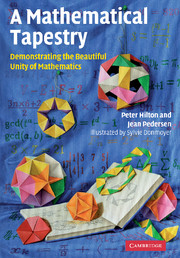Book contents
- Frontmatter
- Contents
- Preface
- Acknowledgments
- 1 Flexagons – A beginning thread
- 2 Another thread – 1-period paper-folding
- 3 More paper-folding threads – 2-period paper-folding
- 4 A number-theory thread – Folding numbers, a number trick, and some tidbits
- 5 The polyhedron thread – Building some polyhedra and defining a regular polyhedron
- 6 Constructing dipyramids and rotating rings from straight strips of triangles
- 7 Continuing the paper-folding and number-theory threads
- 8 A geometry and algebra thread – Constructing, and using, Jennifer's puzzle
- 9 A polyhedral geometry thread – Constructing braided Platonic solids and other woven polyhedra
- 10 Combinatorial and symmetry threads
- 11 Some golden threads – Constructing more dodecahedra
- 12 More combinatorial threads – Collapsoids
- 13 Group theory – The faces of the trihexaflexagon
- 14 Combinatorial and group-theoretical threads – Extended face planes of the Platonic solids
- 15 A historical thread – Involving the Euler characteristic, Descartes' total angular defect, and Pólya's dream
- 16 Tying some loose ends together – Symmetry, group theory, homologues, and the Pólya enumeration theorem
- 17 Returning to the number-theory thread – Generalized quasi-order and coach theorems
- References
- Index
11 - Some golden threads – Constructing more dodecahedra
Published online by Cambridge University Press: 10 November 2010
- Frontmatter
- Contents
- Preface
- Acknowledgments
- 1 Flexagons – A beginning thread
- 2 Another thread – 1-period paper-folding
- 3 More paper-folding threads – 2-period paper-folding
- 4 A number-theory thread – Folding numbers, a number trick, and some tidbits
- 5 The polyhedron thread – Building some polyhedra and defining a regular polyhedron
- 6 Constructing dipyramids and rotating rings from straight strips of triangles
- 7 Continuing the paper-folding and number-theory threads
- 8 A geometry and algebra thread – Constructing, and using, Jennifer's puzzle
- 9 A polyhedral geometry thread – Constructing braided Platonic solids and other woven polyhedra
- 10 Combinatorial and symmetry threads
- 11 Some golden threads – Constructing more dodecahedra
- 12 More combinatorial threads – Collapsoids
- 13 Group theory – The faces of the trihexaflexagon
- 14 Combinatorial and group-theoretical threads – Extended face planes of the Platonic solids
- 15 A historical thread – Involving the Euler characteristic, Descartes' total angular defect, and Pólya's dream
- 16 Tying some loose ends together – Symmetry, group theory, homologues, and the Pólya enumeration theorem
- 17 Returning to the number-theory thread – Generalized quasi-order and coach theorems
- References
- Index
Summary
How can there be more dodecahedra?
It's an interesting fact that if you draw a regular pentagon and then extend its sides you will get a regular pentagram (5-pointed star polygon) that surrounds it. Then if you join the vertices of the pentagram you get another pentagon whose extended sides produce yet another pentagram, and so on, each configuration being larger than the previous one. Or, you can go the other way; by beginning with a pentagon you can construct, by joining every other vertex, a pentagram whose sides intersect on the boundary of a smaller regular pentagon. Then the process can be repeated, producing alternately a pentagram, pentagon, pentagram, pentagon, … each inside the previous drawing. See Figure 11.1 where the faces of the special dodecahedra we will describe in this section are labeled.
Hermann Weyl (1885–1955) recalled that when a pentagram has one vertex pointing straight down it is a symbol for evil and when one vertex is pointing straight up it is a symbol for good. It is amusing that in Weyl's book, the pentagram is shown with one side parallel to the vertical side of the page, so that it points neither up nor down. We used the symbol for good in our illustration of Figure 11.1. An interesting feature of any pentagon is that the ratio of its diagonal to its side is the golden ratio.
- Type
- Chapter
- Information
- A Mathematical TapestryDemonstrating the Beautiful Unity of Mathematics, pp. 163 - 174Publisher: Cambridge University PressPrint publication year: 2010



